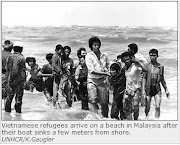Why they fled: The fall of Saigon
Broadcast Date: May 1, 2000
Just before dawn on April 30, 1975, a helicopter rises into the sky over Saigon. It is carrying the last-remaining American marines out of Vietnam. Fourteen years of war between American-backed South Vietnam and communist North Vietnam are over.
But the exodus of people from Vietnam has only begun. Vietnamese refugee Francis Win was only a boy when his family fled, but he talks to CBC Television about the arrival of the Communists and the difficult years that followed.
The air evacuation from Saigon was supposed to be one of the largest transports of refugees ever undertaken. The Pentagon had been told to plan for the movement of 175,000 South Vietnamese who were in danger of being executed by the Communists for their service to the South Vietnam government or the United States. In reality, only a small fraction of that number were evacuated.
The scenes were wrenching — people trying and failing to force their way into the U.S. Embassy, men being punched down as they tried to board American helicopters, Vietnamese babies being passed over fences to open hands and an unknown future.
Those South Vietnamese allies left behind faced years of hard labour, imprisonment and death. The same was true for American allies in Laos, where an estimated ten per cent of the Hmong tribespeople were killed by Communist forces.
Those who could, fled — by air, land or sea. In the spring of 1975, 130,000 refugees escaped Vietnam. Tiny boats full of South Vietnamese soldiers and their families set off down the Mekong River in the hopes of surviving the 600 mile journey to the Malaysian coast. They were the first wave of Vietnamese boat people. But they were not the last
source : http://archives.cbc.ca/society/immigration/topics/524/
Sunday, November 9, 2008
Subscribe to:
Post Comments (Atom)




















No comments:
Post a Comment